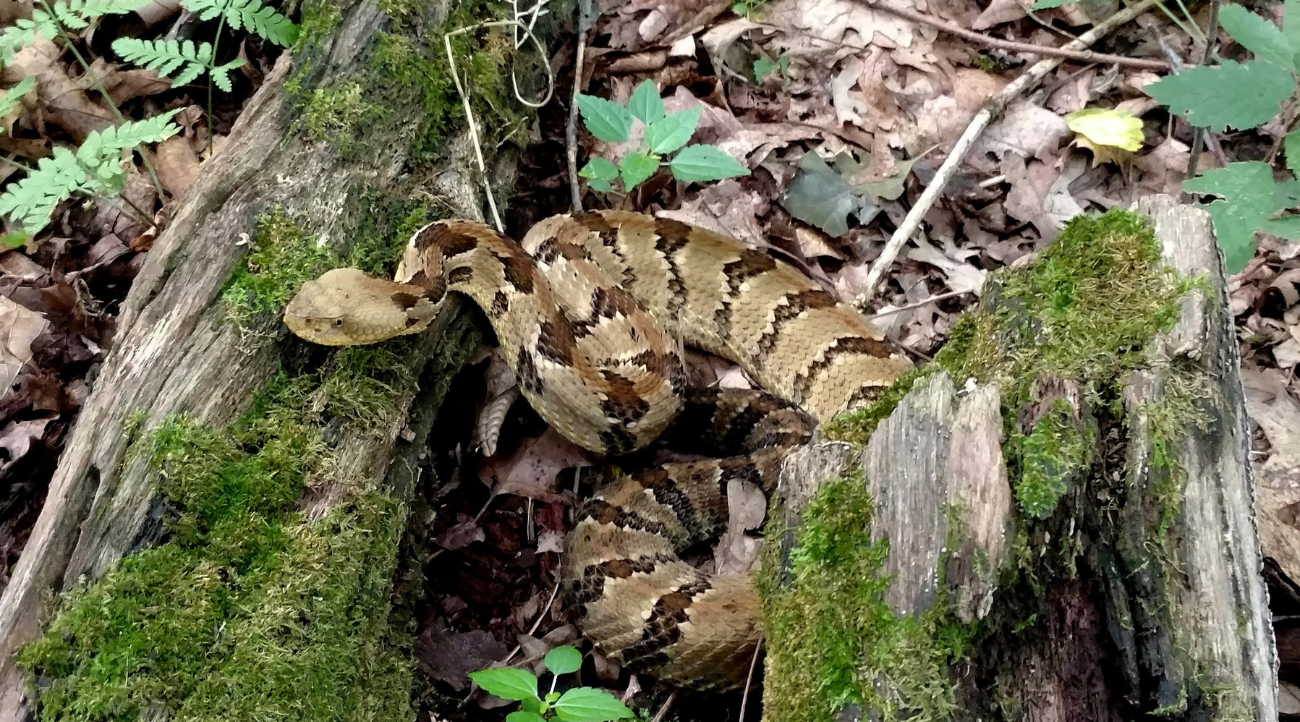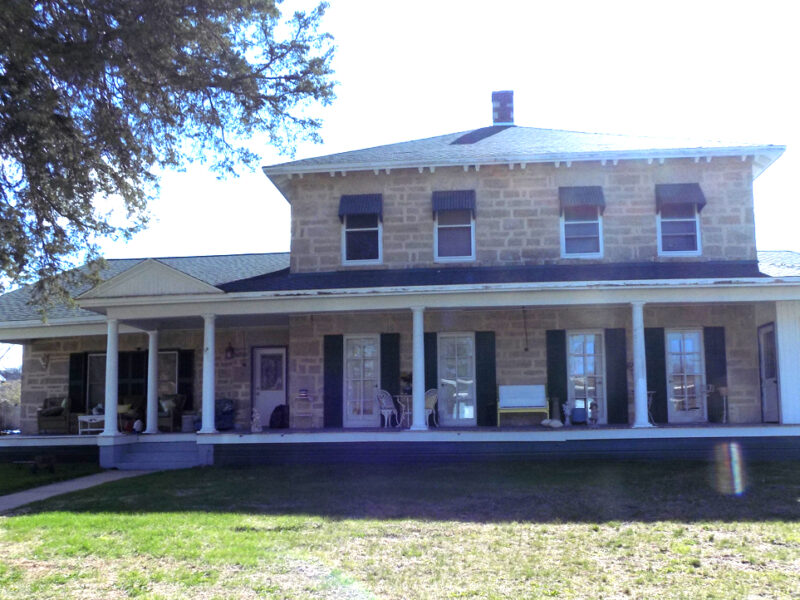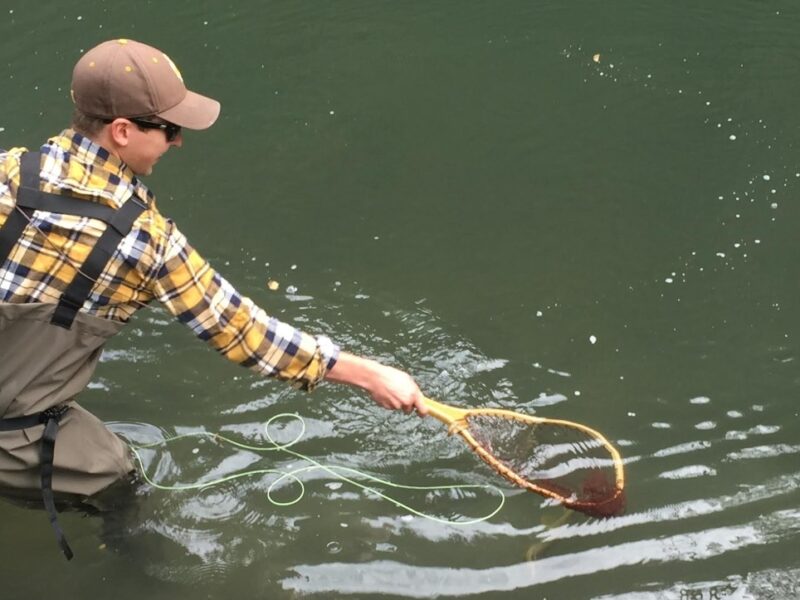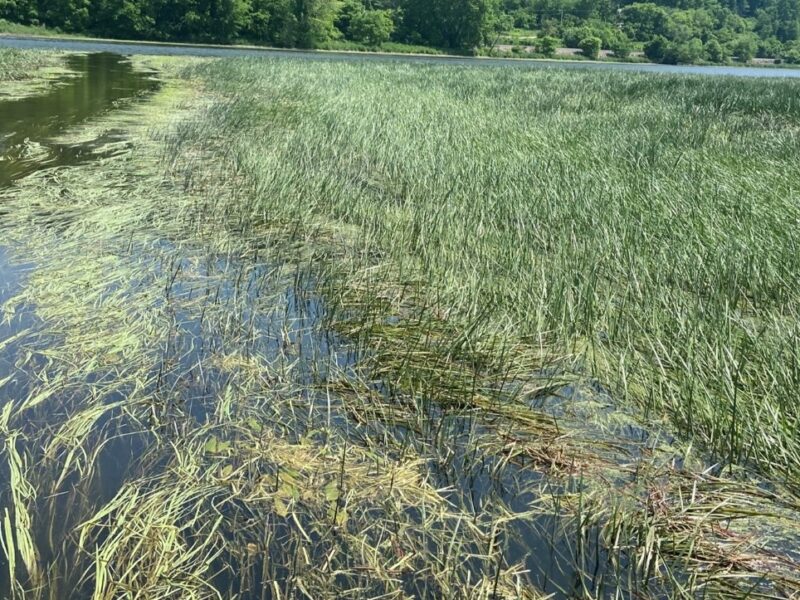A timber rattlesnake utilizing woodland habitat. (Photo by Stephen Winter)
Rattlesnake Responders Work To Bring Timber Rattlesnakes Back From The Brink
Some ‘neighbors’ can be more challenging to live with than others — but understanding, respecting and choosing to live with these Root River valley-area neighbors makes for a better community!
BLUFF COUNTRY, MN – By the time wildlife biologist Stephen Winter responded to a call for a rattlesnake stuck under someone’s porch, he had already wrangled plenty of snakes.
A member of Minnesota’s Department of Natural Resources (DNR) volunteer network called the Rattlesnake Responders, Winter remains on-call to help homeowners safely deal with one of the state’s most threatened – and most threatening – reptiles: the timber rattlesnake. But the snake under the porch posed a special challenge.
“The house had an egress window under the porch,” Winter recalled. “When I got there, I was able to crawl under and see the snake down there.” Because timber rattlesnakes are venomous, safety is the top priority for Rattlesnake Responders. Halfway under the porch, Winter remembered thinking, “I can get in there. But if that snake decides to get frisky, can I get out fast enough?”
He and the landowner resorted to tearing boards off the porch to access the snake from above. When that didn’t work, they brought out a garden hose. “I was able to herd it like a sheep, to move it exactly where I wanted,” Winter said.

Rattlesnake Responders use a special snake hook to harmlessly scoop rattlesnakes off the ground. Dr. Dan Keyler is shown wrangling a large timber rattlesnake. (Photo by Barney Oldfield)
Using his snake hook – a long pole with an end specially curved to scoop around the body of a snake – Winter stashed the snake in a canvas bag and then released it at a DNR-approved release site nearby.
This was another success story for the Rattlesnake Responder program, which has been active for over 25 years. The program aims to protect individual snakes, reduce the chances of a negative human-snake interaction and provide an educational opportunity for landowners who coexist with rattlesnakes.
Julia Geschke, with the Minnesota DNR, coordinates Rattlesnake Responder volunteers. She stressed how important it is that snakes are relocated by a responder, instead of illegally killed by a landowner, in which case: “You lose those reproductive adults, and it slows down the growth rate of the population.”
According to Winter, timber rattlesnakes take their time to mature, with females first reproducing at 6 to 11 years old, after which they give birth every 3 to 5 years. Unlike most snakes, baby timber rattlesnakes (called neonates) are born live, without spending any time in an egg.
For their first winter, these neonates follow the scent trail of their mother to the winter den – usually a crevice in the limestone façade of a prairie bluff. There, they’ll spend a sluggish winter in the cold-blooded version of hibernation, called brumation.
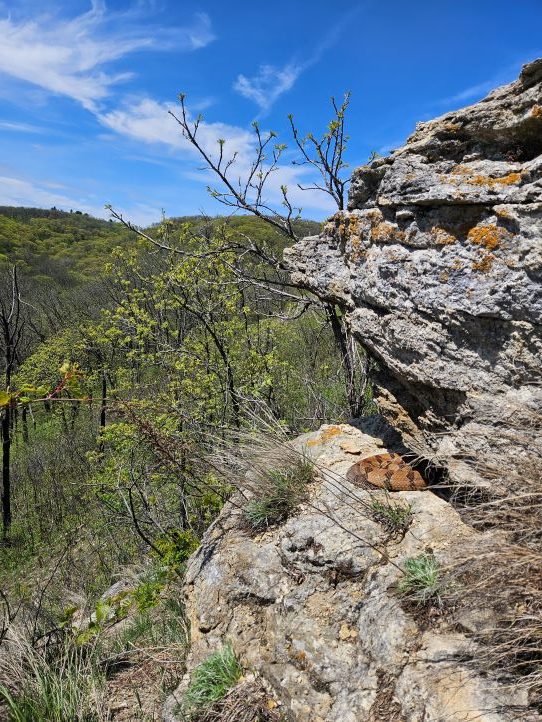
A timber rattlesnake soaks up the sun on a limestone outcropping on a bluff prairie in Southeast Minnesota. Snakes, like other cold-blooded animals, use sun-soaked rocks to regulate their body temperature. (Photo by Julia Geschke)
Timber rattlesnakes return each winter to the same den, which is one of the reasons that relocating them can be such a challenge.
“If they can’t find their original winter den, they most likely won’t survive,” Winter said. “They may slither past another winter den and not use it.”
Rattlesnake Responder protocol is to release each timber rattlesnake within a half mile of its capture site. Releasing the snakes so close to where they were captured seems like it could be an unappealing prospect to snake-averse landowners, but that’s where the education aspect comes in: Rattlesnake Responders make sure to give landowners tips to keep the rattlesnakes in the wild and away from the house.
“The main thing you want to do is eliminate anything that would attract the snakes to your yard,” Geschke advised. That means keeping rodents, which rattlesnakes prey on, away, too. Pet food, bird seed and other rodent-attractants should be kept inside or elevated out of reach of hungry mice and chipmunks.
Stacked wood, cracks in stone foundations and discarded tin, plastic, or landscape fabric are favorite places for snakes to hide during the day. If after all that yard cleanup a rattlesnake arrives anyway, the Rattlesnake Responders are on-call to whisk them away again.
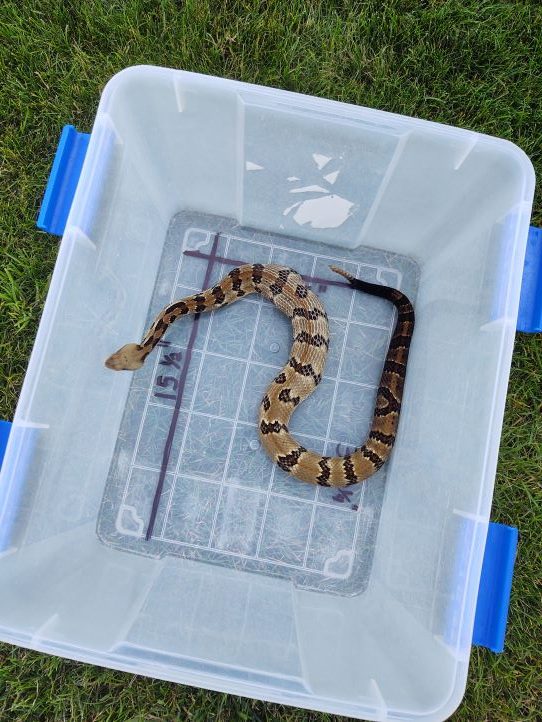
A timber rattlesnake captured by Stephen Winter awaits relocation in Southeast Minnesota. (Photo by Stephen Winter)
A Turbulent History For Timber Rattlesnakes
Timber Rattlesnakes haven’t always been as well-cared for by the state of Minnesota. Up until 1989, there was an active bounty out for Timber Rattlesnakes. Over the 20th century, thousands of snakes were killed. The bounty was in place because they were considered a dangerous animal, though instances of timber rattlesnakes biting and envenomating people are quite rare in the state.
The bounty was repealed in 1989 thanks to the advocacy of veterinarian Dr. Barney Oldfield and Dr. Dan Keyler. Dr. Keyler, now retired, was a clinical professor at the University of Minnesota as well as the Hennepin County Medical Center toxicologist. As such, he has consulted for 21 timber rattlesnake bites in Minnesota over the last 38 years. Those 1 to 2 hospitalizations per year contrast with much higher instances of dangerous deer encounters, which according to the Minnesota Department of Public Safety are responsible for roughly 25 hospitalizations and 3.5 deaths per year.
In a 2023 report, Dr. Keyler found that 86% of timber rattlesnake envenomation events involved males, with 31% of those instances a result of handling rattlesnakes with bare hands.
“If you see a snake, you don’t have to approach it,” Dr. Keyler recommended. “It’s not going to chase you down and attack you.”
The Rattlesnake Responder program works to prevent envenomation, as the snake handling is done by trained volunteers. But even with safe relocations, and the bounty repealed, timber rattlesnake populations are struggling throughout Southeast Minnesota. That’s because these state-threatened snakes depend on a specific habitat: bluff prairies.
On a bluff prairie, free from the shade of trees, rattlesnakes’ rocky dens can heat up faster. Cold-blooded rattlesnakes depend on this energy boost of sunlight, especially as they emerge in the spring. But fire suppression, combined with the introduction of a myriad of invasive species, has shaded out many bluff-prairies over the past two hundred years.
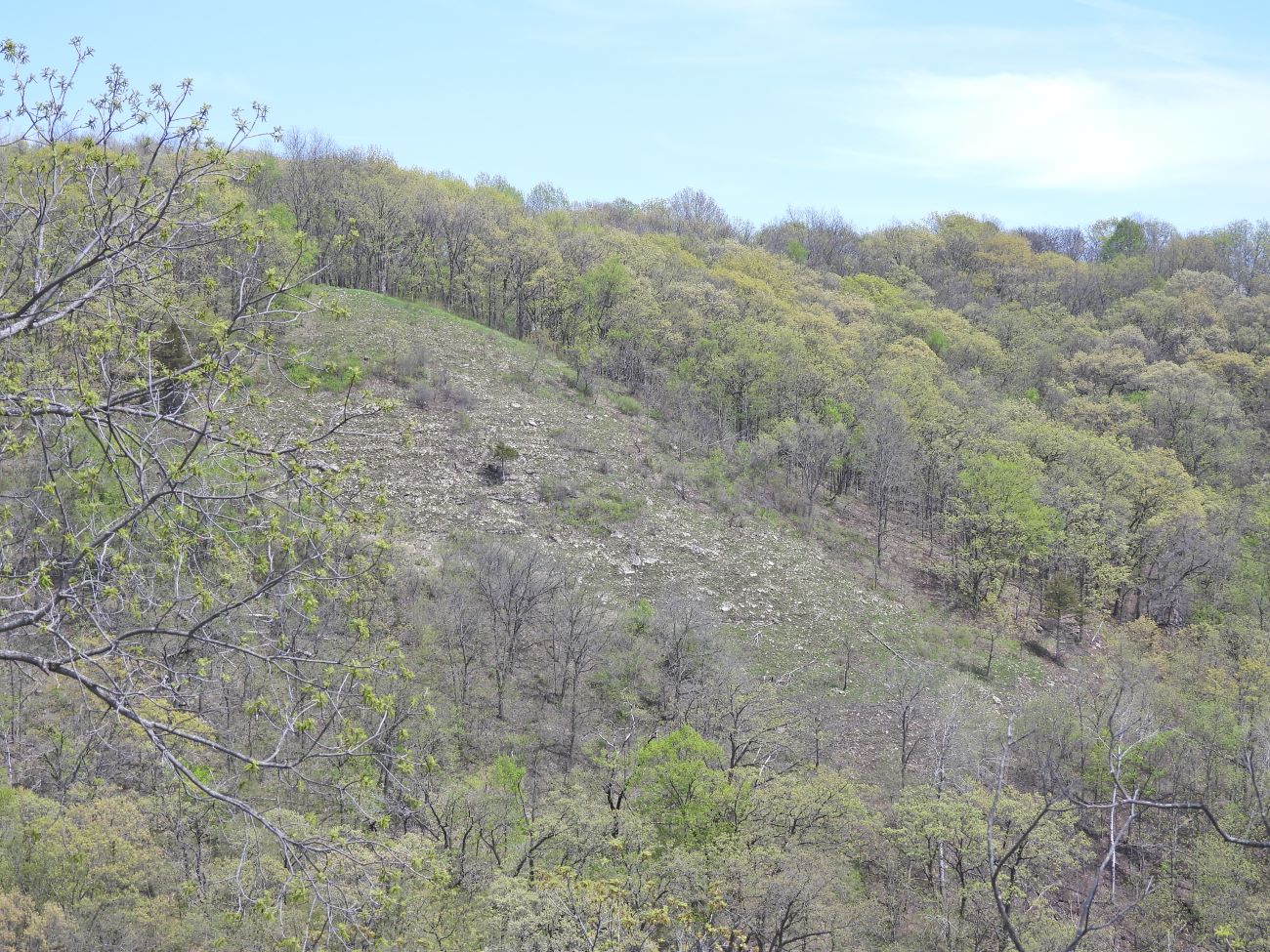
A small slice of bluff prairie, surrounded by encroaching woodland. Timber rattlesnakes depend on intact bluff prairie for nesting. (Photo by Julia Geschke)
“Eastern cedars have been an invasive species that chokes out a lot of things,” Dr. Keyler specified. “Sometimes the canopy can over-shelter some of the den sights. Some of those areas have been opened up and the bluffs cleared of cedars which creates favorable habitat for the rattlesnake, allowing them to stay there rather than search and try to find open habitat somewhere else.”
The Minnesota DNR, as well as non-profit groups like the Nature Conservancy and the Prairie Enthusiasts, are working to restore prairie habitat in Southeast Minnesota. It remains to be seen how much these habitat improvements will stabilize rattlesnake populations across the region.
Residents Of Southeast Minnesota Can Help Protect Timber Rattlesnakes
Not everyone is a so-called “snake person”. Those who work closely with the snakes, like Winter, Geschke, and Dr. Keyler, have a unique appreciation for an animal that often inspires fear or dread in most people.
Protecting rattlesnakes – even restoring your own property to accommodate them – is not always met favorably.
One Minnesotan landowner who has timber rattlesnakes living on her property reported: “I’ve gotten negative comments that we should stop restoring and providing habitat for the snakes.” She chose to remain anonymous for this article to avoid further unwanted attention.
How To Become A Rattlesnake Responder
Unknown numbers of rattlesnakes are killed every year, an illegal act unless the snake is directly endangering a person or pet. But for those interested in helping this threatened animal, the Rattlesnake Responder program is a great start.
“For the growth of the program, we are hoping next year to bring in more volunteers, to build a bigger pool,” Geschke said. “Recruiting other people, particularly in Goodhue, Wabasha, Olmsted, Fillmore, and Houston counties, would be helpful so we make sure we’re not missing calls.”
Volunteers attend an annual training, where they learn proper snake handling techniques and receive equipment. Part of being a Rattlesnake Responder is educating the public on rattlesnake safety and ecology. Going forward, Geschke is looking to turn the program into a tool for science.
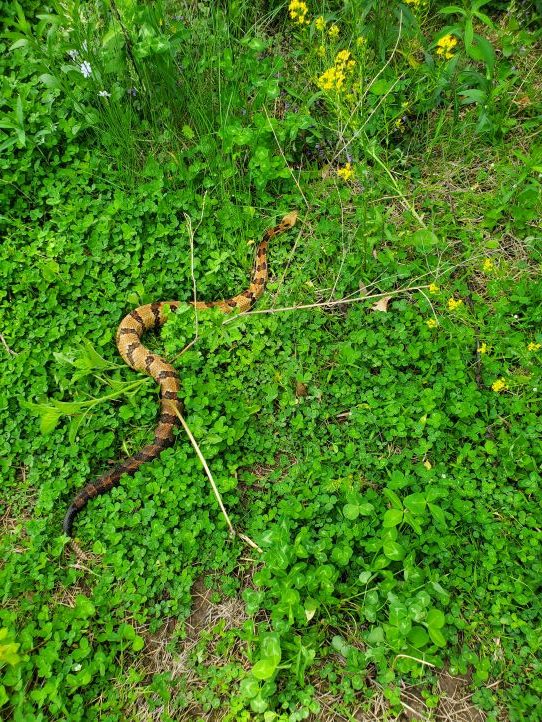
Rattlesnake Responders are on call to help relocate snakes like this one, found in a yard in Southeast Minnesota. (Photo provided by Rattlesnake Responders)
“One thing we’re implementing this year is a digital data form,” Geschke said. “We’re collecting information in this app and that will allow us to get much more accurate locations of where the snake was found and where it was released. We’re also interested in trying to see if there are repeat offenders – if the same snake is coming back to the same house or the same street over and over.”
Meanwhile, the anonymous landowner will continue restoration efforts on her property, including the removal of invasive red cedar. Remembering the first time she saw timber rattlesnakes on her property, she said that “It was one of the most wonderful things I’ve ever seen. It was just so wonderful. Especially with the restoration work we were doing I felt that was further validation that it was helping them in some way…it was improving their habitat. Now, we routinely see them up there.”
Of course, it’s one thing to have a den of venomous snakes high up on your bluff prairie, and quite another to find one under your front porch. The key to the Rattlesnake Responder program is minimizing harmful interactions between Minnesotans and their timber rattlesnake neighbors.
For Winter, the importance of the Rattlesnake Responder program can’t be overstated. “Every homeowner that calls is essentially someone who is willing to live with rattlesnakes,” he stated. “It’s very reassuring and heartwarming to know that there are so many people out there who are willing to share the landscape with timber rattlesnakes.”
A Love For Nature Can Include A Love For Timber Rattlesnakes
Why are people willing to share their yard with a venomous snake? What makes these snakes so special? Each expert I spoke with offered a different answer: they keep ecosystems in balance; they symbolize something wild; saving them pushes back against the extinction crisis; they’re beautiful animals with fascinating behavior.
It was Winter who offered a quote from famed naturalist, Aldo Leopold, that sums up the most practical reason for keeping timber rattlesnakes around: “The first rule of intelligent tinkering is to keep all the pieces.”
Wedged underneath a stranger’s porch, crawling toward a venomous snake, I’m not sure if Winter had philosophy in the forefront of his mind. But in that moment, all the snake needed was someone who cared enough to let it live.
…………………
Read more about this program on the Rattlesnake Responders website. If you find a Timber Rattlesnake, call your local Rattlesnake Responder Hotline:
Fillmore County: 507-765-3874 (ext. 1)
Goodhue County: 651-385-3155
Houston County: 507-725-3379 (ext. 1)
Olmsted County: 507-328-6800 (ext. 1)
Wabasha County: 651-565-3361
Winona County: 507-457-6491
…………………
Contributor
Hugh Gabriel is a writer, educator and scientist based in Minneapolis. His specialties are frog research and prairie restoration, and he currently works at the Bell Museum of Natural History.

This is another in our recurring series of prairie restoration-related stories reported by Root River Current. Other stories include Prairie Strips | Big Benefits, Small Investment, Bold Vision, Deep Roots: Two Southeast Minnesota Nurseries Source Seed For Restoring Native Landscapes and Prescribed Burn Team Treats State Highway Ditches with a Dose of Fire.


